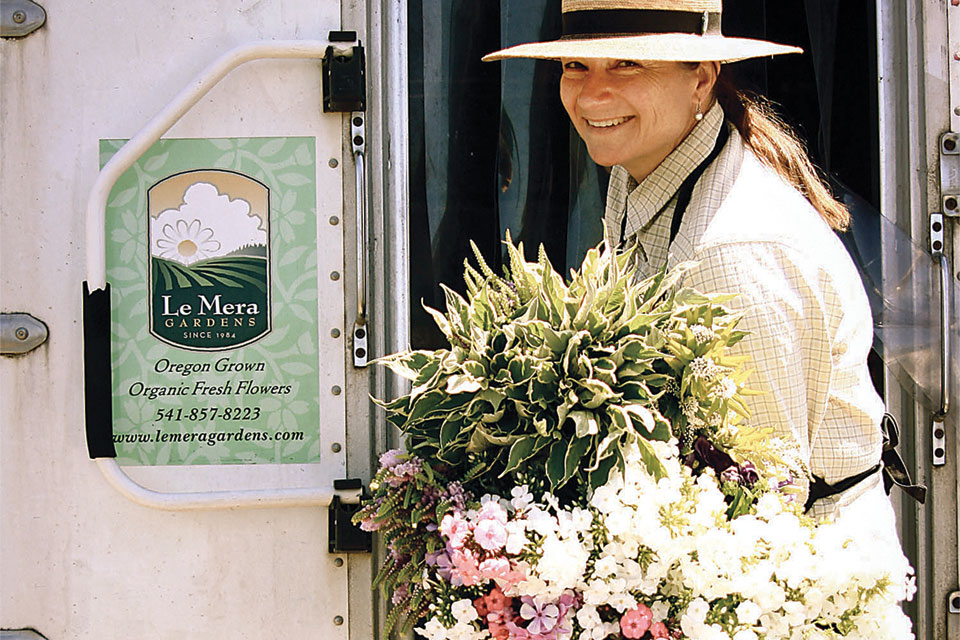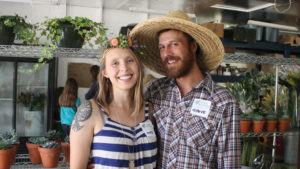Growers Showing Renewed Interest in Specialty Cut Flowers

For almost 25 years, Le Mera Gardens has grown organically certified cut flowers in southern Oregon under the stewardship of Joan Thorndike. Her hoophouses and fields contain lush tulips and ranunculus, hundreds of woody shrubs, and a wide range of diversified annuals and perennials to serve the florist trade of the Rogue Valley. Thorndike also works with brides and grooms who want to be more involved with their wedding bouquets, to the point of making all the flower arrangements themselves. She is an original proponent of the local flower movement. All photos by Judy Laushman, ASCFG
Formed in 1988 as an offshoot of Allan Armitage’s research on field-grown cut flowers at the University of Georgia, the Association of Specialty Cut Flower Growers (ASCFG) has recently experienced tremendous growth in membership. With members in every state except North Dakota, six European countries, and an increasingly visible presence in Canada, the association’s membership rolls have climbed to more than 1,300 and show no signs of diminishing.
Growers are attracted to the organization by its ability to connect members through online forums, social media, and national and regional meetings. The Cut Flower Quarterly, the only national periodical dedicated to the production and marketing of cut flowers, is one of the most important member benefits. Members of the organization have been characterized as uncommonly generous, sharing their growing experiences — good and bad — without worry of market competition or duplication.
The rise of the farmer-florists, those who not only grow cut flowers, but sell directly to the public, often and increasingly, through designs and installations for weddings and other special events, has played an important part in the floral industry. This, of course, is the model of the original flower grower in the U.S., before the chain expanded to include wholesalers, shippers, and importers.

Gretel and Steve Adams are young farmers whose Sunny Meadow Flower Farms, just southeast of Columbus, OH, has gained a reputation for a wide range of quality flowers. Their markets include several high-end grocery stores such as Whole Foods and Heinen’s in Ohio. Gretel and her floral design team are increasingly in demand for wedding and special event arrangements. The farm’s philosophy is to be an inspiration to other farmer-florists, and to be seen by their community as responsible stewards of the land.
Education and Research Efforts Raise Awareness of Cut Flowers
The popular ASCFG Mentorship Program, now in its second season, has provided hands-on support, training, and advice by matching new growers with more experienced farmers. Mentors and mentees communicate regularly, visit each other’s farms, and work together to enable the aspiring farmers to gain advanced farming experience, skill, and perspective as they begin to establish their own operations.
The online company Shopify offers powerful selling tools that the ASCFG has customized and extended to suit specialty cut flower growers — both individual growers and grower cooperatives. The ASCFG Shopify Package includes a customized theme aimed at wholesale sellers (but is also capable of customization to support sellers who serve retail and wholesale customers), a large product catalog featuring hundreds of flowers with gorgeous photos, and an add-on spreadsheet that allows growers to review each week’s orders and produce concise harvest lists each week. Growers can use the ASCFG Shopify Package to simplify and increase sales to wholesale and retail florists, grocery stores, and other buyers, replacing phone and email orders with a quick, online shopping experience.
Under the direction of Dr. John Dole of North Carolina State University, the ASCFG has conducted national trials since 1992, evaluating more than 1,000 cultivars of cut flowers provided by national breeders and suppliers. Members grow the plants, cut and sell the flowers according to their own methods, and rate the varieties based on stem length, stems per plant, postharvest life, and marketability. The association publishes the results in The Cut Flower Quarterly, and shares them with the floral industry.
The organization has recently produced two books. The first is a reprint of “Woody Cut Stems,” which had been unavailable, but is considered a vital source for most cut flower growers. This spring, the ASCFG published “Postharvest Handling of Cut Flowers and Greens: A Practical Guide for Commercial Growers, Wholesalers, and Retailers.” Written by John Dole, Robert Stamps, and their colleagues, this book has filled a huge void: no reference had existed for the process of handling floral material after harvest. Detailed information on stage of harvest, expected vase life, and storage procedures for more than 240 genera of annuals, perennials, woody shrubs, grasses, and tropicals is provided.

In the heart of St. Louis, MS, Mimo and Miranda Davis-Duschack have converted an abandoned 142-year-old florist shop and glass greenhouse and one quarter of a city block into an impressive cut flower operation producing more than 70 types of cut flowers. They sell to farmers’ markets and florists in the region. Their truly urban farm is a model of intensive, sustainable production on a small scale.
ASCFG awards the Dave Dowling Scholarships each year to undergraduate or graduate students enrolled in accredited horticulture or floriculture programs who plan to pursue a career in cut flower production. The availability of Grower Grants encourages on-farm research. Recently funded projects include the examination of steam sterilization of hoophouse soils to combat Rhizoctonia, the evaluation of organic solutions for powdery mildew on zinnias, and peony production in Alaska.
The ASCFG’s visibility, and that of its members’ flowers, have been raised recently by the production and distribution of a short film called “Local Flowers — Local Farmers.” This intimate documentary spends time with members in Pennsylvania, Virginia, and Texas, illustrating first-hand how these innovative and creative growers have established their businesses.
Passionate, Diverse ASCFG Members Lead by Example
Specialty crops include everything from anemones, ranunculus, and peonies in the spring, to summer annuals like sunflowers, zinnias, and celosia, rounding out through fall with dahlias, hydrangeas, and vintage chrysanthemum hybrids, now making a comeback in several markets. Complementing these herbaceous crops is a wide range of other woody shrubs, grasses, herbs, bulbs, and wild-harvested material. As one grower quipped, “If we can cut it, we can sell it.”
ASCFG members are as varied as the crops they produce. They include young farmers with less than an acre to experienced growers with large greenhouses or hoophouses and fields up to several acres. This inspirational combination of creative, passionate, and committed flower growers — young or veteran, urban or rural — is what continues to support the ASCFG. Allan Armitage once called the ASCFG “The little engine that could.” As the organization nears its 30th anniversary in 2018, it’s still full steam ahead.









